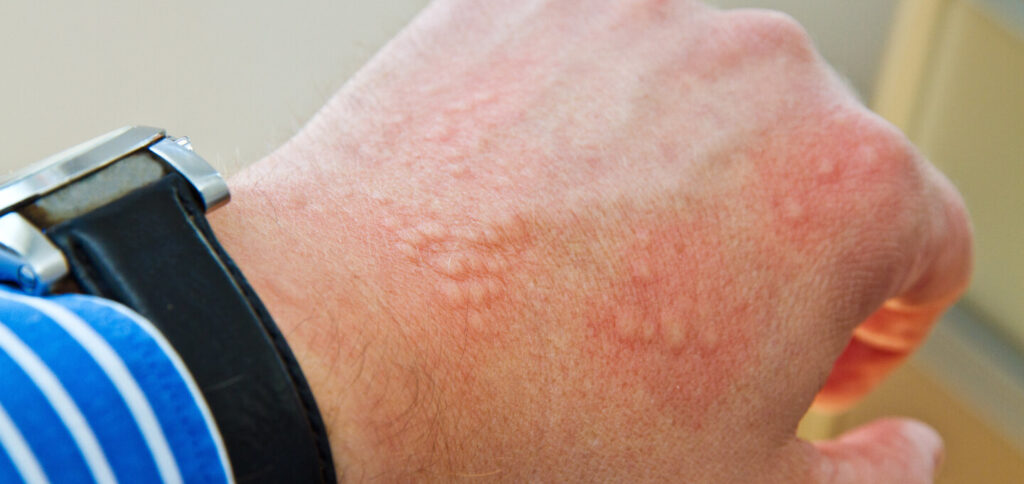
There are many types of allergies. Some are seasonal while others are year-round. Some can also be life-long.
Allergic reactions are classified into four main types.
- Type I or immediate hypersensitivity
- Type II or cytotoxic reactions
- Type III or immunocomplex reactions
- Type IV or cell-mediated allergic reactions
The first three allergic reactions are called ‘immediate types of allergic reactions’ as they occur within 24 hours of exposure to the allergen (3).
Type IV occurs after 24 hours of exposure and is known as delayed allergic reactions.
1. Type I Allergies: Immediate Hypersensitivity

Common allergens that can trigger Type 1 allergies include pollen, animal dander, insect venom, certain medications, and foods such as peanuts, tree nuts, shellfish, and eggs.
Type 1 allergies are also known as immediate or IgE-mediated hypersensitivity reactions. In response to the allergy, your body releases antibodies known as immunoglobulin-E or IgE which targets that particular allergen.
The underlying mechanism in type-1 allergies:
- If you have a Type-1 allergy and you get exposed to an allergen, your immune system will produce large amounts of antibodies specific to that allergen.
- These antibodies bind to immune cells (mast cells and basophils) in the body, causing them to release histamine and other chemical mediators.
- These chemical mediators cause the symptoms associated with an allergic reaction, such as itching, hives, nasal congestion, and in severe cases, anaphylaxis. (4), (5).
Example: With food allergies, you may end up with unpleasant reactions immediately after eating the food or a couple of hours later. Your face, mouth, lips, throat, etc. may swell up. You may end up with nasal congestion, itching, or even hives. If the throat swells too much, it can choke you. Severe food allergy reactions can result in life-threatening anaphylaxis.
Type-I hypersensitivity reactions are seen in:
1. Allergic rhinitis: This is also called hay fever. This happens when your immune system overreacts to an inhaled allergen such as pollen, mold, etc. You may end up with itchy eyes, sneezing, a runny nose, and congestion.
2. Bronchial asthma: Allergic asthma can also occur as an overreaction to inhaled allergens. But this gets more serious as it may lead to swelling inside the airways of the lungs, making it difficult for you to breathe. Triggers include strong odors, tobacco smoke, dust mites, pollen, etc.
3. Allergic conjunctivitis: This is a type of eye inflammation resulting from allergic reactions to pollen, animal dander, dust mites, etc. The symptoms of allergic conjunctivitis include redness, itching, tearing, and swelling of the eyelids. You may also experience a burning sensation, a feeling of grittiness in the eye, and increased sensitivity to light.
4. Skin allergies: Eczema and hives are the two main types of skin allergies. Atopic dermatitis or eczema can show up at any age and you end up with dry, red, itchy skin. Their intensity ranges from mild to severe. Hives or urticaria show up as red, itchy, bumpy skin rashes that can appear anywhere or all over your body in varying shapes and sizes. Hives are extremely uncomfortable, but they usually resolve within a day or two.
What causes Anaphylaxis?
Type-I hypersensitivity can lead to a potentially life-threatening allergic reaction known as anaphylactic shock.
Anaphylaxis is a potentially life-threatening, severe allergic reaction that occurs within seconds or minutes of exposure to allergens such as peanuts or even a bee sting.
You may experience breathing difficulty, wheezing, rapid heartbeat, drop in blood pressure, dizziness, and nausea. Food allergies, allergic asthma, and insect bites can trigger anaphylactic shocks.
Anaphylaxis is a medical emergency and requires immediate treatment with epinephrine injections which can quickly reverse the symptoms of the allergic reaction. People who are at risk of anaphylaxis to carry an epinephrine auto-injector with them at all times for such emergencies.
2. Type II: Cytotoxic-Mediated Reactions

Type II hypersensitivity reactions are also known as cytotoxic reactions.
The underlying mechanism in type-II allergies:
- This is a type of immune reaction that takes place when your immune system produces antibodies, such as IgM or IgG, against antigens present on the surface of cells or tissues.
- These antibodies bind to the cells or tissues, marking them for destruction by natural killer cells (macrophages) of the immune system (6).
Example: This type of reaction or allergy can occur during blood transfusions. The immune system produces antibodies against the antigens on the surface of the transfused red blood cells, leading to their destruction. This releases hemoglobin into the bloodstream and can cause symptoms such as fever, chills, and shortness of breath.
Type-II allergic reactions can be seen in conditions like:
- Graves’ disease: This is an autoimmune disorder where the immune system attacks the thyroid gland, causing it to overproduce hormones that regulate metabolism. This can lead to symptoms such as weight loss, rapid heartbeat, and nervousness.
- Hemolytic anemia: This is a condition where the immune system attacks and destroys red blood cells, leading to anemia (low red blood cell count) and symptoms such as fatigue, weakness, and shortness of breath.
- Pemphigus: This is a rare autoimmune disorder where the immune system attacks the skin and mucous membranes, causing painful blisters and sores.
- Myasthenia gravis: This is a neuromuscular disorder where the immune system attacks the receptors that allow nerves to communicate with muscles. This can lead to muscle weakness, fatigue, and difficulty with movement.
- Good pasture syndrome: This is a rare autoimmune disorder where the immune system attacks the kidneys and lungs, causing damage to these organs and leading to symptoms such as cough, shortness of breath, and blood in the urine.
FYI: What is the difference between antigen and allergen?
Antigens trigger your immune system to produce antibodies. All allergens are antigens since they trigger an immune system response. But all antigens are not allergens. Examples of antigens include bacteria, viruses, pollen, etc.
3. Type III or Immunocomplex Reactions

Type III allergies are also known as immune complex reactions.
The underlying mechanism in type-III allergies:
- Immune complexes are clusters of antigens and antibodies that can build up in various tissues in the body. IgG, IgM, and sometimes IgA antibodies react with the soluble allergens to build up these immune complexes (antigen-antibody complexes).
- These can cause inflammation and tissue damage, resulting in various symptoms and health complications. Symptoms may take several hours to appear after exposure.
Examples: Rheumatoid Arthritis (RA) is a classic example of type III allergy. Rheumatoid Arthritis is a chronic autoimmune disease that primarily affects the joints, causing inflammation, pain, and joint damage.
Type-III allergic reactions can be seen in conditions like:
- Serum sickness can occur after exposure to certain medications, such as antibiotics or antiserum.
- Lupus is a chronic autoimmune disease that can affect different organs and tissues in the body.
- Farmer’s Lung is a type of hypersensitivity pneumonitis caused by exposure to organic dust from hay, grain, etc.
- Glomerulonephritis is an inflammation of the kidney that can lead to impaired kidney function.
4. Type IV Allergies: Cell-Mediated Reactions

Type IV allergies are also known as delayed-type hypersensitivity or cell-mediated hypersensitivity. This type of allergic reaction is typically delayed, with symptoms appearing hours to days after exposure.
Type IV allergies are caused by a specific type of immune response involving T cells.
The underlying mechanism in type-IV allergies:
- The immune system is exposed to an allergen, antigen-presenting cells (APCs), such as dendritic cells, engulf the allergen and display fragments of it on their cell surface.
- Helper T cells (Th cells) recognize the allergen fragments and become activated, triggering an immune response.
- The activated T-cells release cytokines, which attract and activate natural killer cells of the immune system (macrophages and T cytotoxic cells).
- The immune cells migrate to the site of allergen exposure and release inflammatory mediators, such as histamine and leukotrienes. This causes inflammation, redness, itching, and other symptoms.
- The immune system also produces memory T cells that recognize the allergen in the future and mount a more rapid and vigorous response.
Example: The test for tuberculosis makes use of this mechanism. To check if a person has been exposed to tuberculosis bacteria, a small amount of allergen (purified protein derivative – PPD) is injected under the skin. The area is checked for a reaction 48-72 hours later.
Type-IV allergic reactions can be seen in medical conditions such as:
- Contact dermatitis: These are skin reactions that occur when your skin comes into contact with an allergen, such as poison ivy, certain chemicals, etc. Symptoms of contact dermatitis include redness, itching, and blisters.
- Allergic contact mucositis: This is a type of allergic reaction that occurs when the mucous membranes of the mouth, nose, or eyes come into contact with an allergen, such as certain medications or chemicals. Symptoms may include redness, itching, and swelling.
- Multiple sclerosis: This is a neurological disorder where the immune system attacks the myelin sheath that covers nerve fibers in the brain and spinal cord. This can lead to symptoms such as muscle weakness, tingling, and difficulty with coordination.
- Granulomatous inflammation: This is a type of inflammatory response that occurs when the body tries to contain and isolate a foreign substance, such as a microbe or allergen. This can lead to the formation of small nodules called granulomas.
Conclusion
Allergies can significantly impact your daily functions and lower your quality of life. Many treatment options are available to help alleviate your symptoms.
However, you need to identify your allergy triggers before you can treat them. Understanding what causes allergies, and their symptoms will help you decide on an effective course of treatment. You can consult with your doctor to determine the best course of action for managing your allergies.
Read more: Complete Guide to Understanding Allergies: Causes, Symptoms, Diagnosis, and Effective Treatments
Read more: Uncovering the Root Causes of Allergies: Common Triggers and Risk Factors
